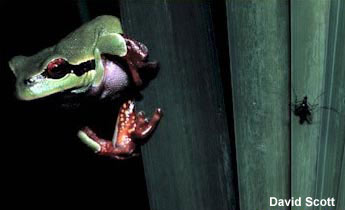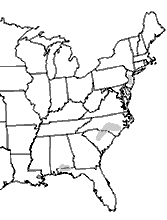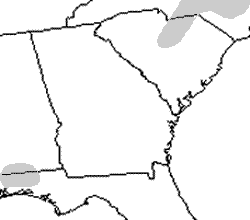Pine Barrens Treefrog (Hyla andersonii)
Pine Barrens Treefrog (Hyla andersonii)



Description: A mid-sized treefrog (2.8–4.4 cm; 1–1.75 in) with green dorsal coloration and expanded sticky toe pads. Distinguished by bold lavender stripes, bordered in cream or white, that extend from the eyes down the sides, forming a mask-like appearance. The concealed surfaces of the hind legs are orange. Males are smaller than females and exhibit loose throat skin during the breeding season.
Range and Habitat: It occurs in three disjunct populations: the Pine Barrens of New Jersey, the Sandhills of southern North Carolina and northern South Carolina, and the Florida Panhandle. It prefers acidic wetlands such as bogs, pocosins, Carolina Bays, and cypress swamps within pine-dominated uplands. Moist bottomland hardwood forests of the Coastal Plain may serve as marginal habitat but are less frequently occupied.
Habits: Primarily nocturnal and secretive, seldom encountered outside the breeding season. Breeding occurs in late spring and summer, with activity concentrated around acidic, fishless wetlands.
Call: A nasal “waank, waank,” lower in pitch and less far-carrying than the similar call of the Green Treefrog (D. cinereus). Because of this similarity, the distribution of D. andersonii may be under- or misreported where the two species overlap.
Conservation Status: It is not federally listed, but it is listed as a species in need of management or threatened in South Carolina. Its restricted range and specialized habitat requirements make it vulnerable to habitat loss and degradation, particularly wetland drainage and alteration of pine upland ecosystems.
